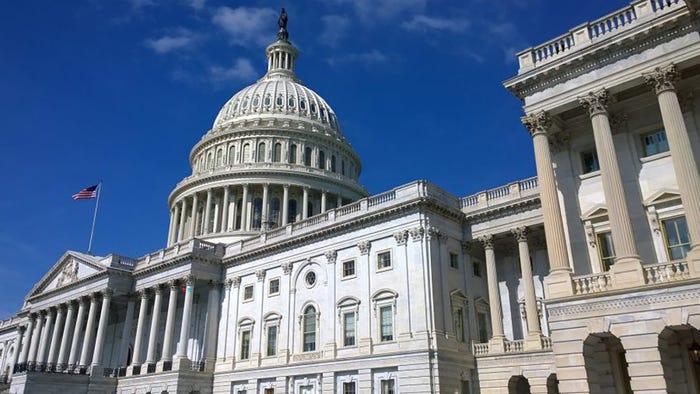FirstNet Authority board commits to first in-building investmentFirstNet Authority board commits to first in-building investment
May 6, 2022
.jpg?width=1280&auto=webp&quality=95&format=jpg&disable=upscale)
FirstNet Authority board members this week voted to make a multimillion-dollar investment that is designed to extend the coverage of FirstNet—the nationwide public-safety broadband network (NPSBN) being built by AT&T—inside public-safety buildings and other structures.
FirstNet Authority Chair Stephen Benjamin described the in-building resolution as an “exciting investment,” and the measure was approved unanimously during the FirstNet Authority board meeting conducted Wednesday.
While broadly applauded as the first tangible step toward addressing FirstNet in-building coverage, the resolution does not include a specify the amount of the investment or how the money would be distributed. A FirstNet Authority spokesperson informed IWCE’s Urgent Communications that the in-building initiative is multimillion-dollar investment and that deployment details will be shared in the future.
This investment is expected to fund small-cell technology that is designed to improve FirstNet coverage where subscribing agencies work indoors, including police headquarters, fire stations and 911 centers. This is important, because a vast majority of public-safety respondents to a FirstNet Authority indicated that they spend more than half of their time indoors, according to FirstNet Authority Vice Chair Richard Carrizzo.
“As public-safety agencies depend more and more on these mobile devices, … it’s their primary module for first responders to access all of their mission-critical applications and functions that they use every day,” Carrizzo said during the board meeting. “It’s critical that connectivity is available not just outdoors, but indoors where responders spend that time.
“The investment will provide Band 14 in-building coverage extension to primary public-safety agencies, deployed at their discretion … They can use them when and where they need them. So, they can use them in police stations, EMS stations and fire stations. We’ve seen them being in used in COVID times with 911 operators operating out of their houses, where they needed coverage.”
FirstNet Authority board member Sylvia Moir—a former police chief—said the small-cell technology will provide FirstNet public-safety users with an alternative to unlicensed Wi-Fi systems when working indoors at public-safety locations.
“Public safety desires the same prioritized, seamless user experience that they get outdoors when they are operating indoors for their primary work location,” Moir said during the board meeting. “This investment to provide a small-cell product that operates on our Band 14 spectrum will improve the network experience for public safety [and] provide reliable FirstNet connection, which brings mission-critical services indoors, such as push-to-talk [voice communications] and video.
“It will enable a more reliable handoff to and from the macro network as a law-enforcement employee or operator moves from our station to vehicles. This solution will also improve the efficiency and ensure access to mission-critical functions when and where first responders need them to do their jobs to safeguard the members of their community.”
FirstNet board member Peter Koutoujian echoed Moir’s law-enforcement sentiments while also noting some unique communications challenges facing sheriff offices—notably, the administration of county jails.
“These environments can be quickly dangerous, even in the best-run correctional facilities,” Koutoujian said during the board meeting. “Our research and engagement with the public-safety community found that while larger agencies often have access to complex in-building solutions, thousands of small-to-mid-sized agencies—which … reflects most of our sheriff offices across the country—typically do not have the same level of information-technology support and have expressed strong interest in a FirstNet-supported option.
“A lack of in-building coverage in all types of buildings presents an issue for law enforcement that will increasingly become a barrier to FirstNet adoption as the use of mobile applications for public safety grows. This investment should really help public safety and provide greater equity, as well, between all of the sheriff offices and law-enforcement agencies across this county—no matter their size—by providing a cost-effective solution for access to the FirstNet network where and when they need it.”
In-building coverage has long been cited as a priority in the FirstNet Authority’s roadmap that guides the use of the organization’s reinvestment funds—about $15 billion over the life of the 25-year contract with AT&T—but this week’s resolution marks the most tangible move by the organization to address the indoor-coverage issue.
Benjamin noted the role that public safety’s input has played in directing the organization’s network decisions, including this in-building initiative.
“Public safety is at the center of our investment process—the FirstNet Authority is laser focused on making sure the network continues to provide the communications they need for their mission,” Benjamin said in a prepared statement. “Through our dialog with public safety, they point to in-building coverage as a top priority for FirstNet. With this investment, we will enhance indoor coverage, provide an additional layer of network resiliency, and give public safety the ability to deploy this service where and when they need it the most.”
FirstNet Authority CEO Ed Parkinson—participating in his final board meeting before joining RapidSOS next week—agreed.
“The FirstNet Authority has a strong partnership with public safety so we can make investments that advance the network to benefit their operations,” Parkinson said in a prepared statement. “In-building coverage routinely tops the list of their desired improvements for FirstNet, so we are thrilled to be investing in a service that will help public safety deploy more localized and focused coverage solutions.”
Jason Porter, president of AT&T’s public-sector and FirstNet business units, applauded the action in a statement provided to IWCE’s Urgent Communications.
“The need for in-building, dedicated public-safety connectivity is essential to first-responder operations, as well as the overall safety of the communities they serve,” according to Porter. “That’s why I’m excited FirstNet—America’s public-safety network—will grow, thanks for our strong public-private partnership with the FirstNet Authority and its recently announced network investment. It’s just one more way FirstNet innovates for the public-safety community.”
Earlier this year, AT&T became a member of the Safer Buildings Coalition (SBC) and participated in in-building sessions organized by SBC during the IWCE event in March. SBC Managing Director John Foley expressed support for the FirstNet Authority board’s initial commitment to tackle the in-building coverage issue.
“The Safer Buildings Coalition is excited to see FirstNet focus reinvestment funding for FirstNet to work inside buildings,” Foley said during an interview with IWCE’s Urgent Communications. “We look forward to continued collaboration with both AT&T and FirstNet to evolve this important capability.”
Former FirstNet Authority Vice Chair Jeff Johnson—one of the most outspoken proponents of in-building solutions during his tenure on the board—described the resolution as “a great decision” and said he is hopeful that it is just the beginning of a focus on indoor coverage for FirstNet.
“I’m very pleased that they made an investment in this area, because in-building [connectivity] is the next frontier, and FirstNet has chosen to embrace that challenge,” Johnson said during an interview with IWCE’s Urgent Communications. “I think this should be—and is likely to be—the first of many steps along this path, because if you’re public safety, you have to solve in-building, and I think this reinvestment by the authority says that they recognize it.”
While this resolution directs funding for in-building coverage for first responders using FirstNet inside of public-safety facilities, there has been growing momentum in recent years for buildings to bolster in-building coverage for others, as well. Johnson has been among those who have noted the importance of wireless in-building connectivity to support citizen calls to 911 at a time when the number of landline phones continue to dwindle and payphones are extremely rare in most areas of the country.
“For the first time in 20 years—in my view—you’re watching a recognition that in-building coverage is valuable for the building owner, the people that occupy that building, and public safety,” Johnson said. “I think we’re watching a natural migration to a more comprehensive solution. Because, at the end of the day, the people calling 911 need coverage in that building, and building owners are finding that it’s hard to rent a building that doesn’t have adequate broadband coverage, and public safety needs it for obvious reasons.
“To me, we’re at the front edge of a really sophisticated and comprehensive discussion. I see the reinvestment dollars made available by Chairman Benjamin and the FirstNet Authority … as a signal. It’s a signal that this is important, and collectively, we’re going to make a substantial, long-term investment here. And that investment is not just money; it’s an intellectual investment in what’s the best path forward.”
Money for the in-building initiative will come from payments made by AT&T to the FirstNet Authority as part of a 25-year contract that was signed in March 2017.
At that time, AT&T was named as the nationwide FirstNet contractor, with the opportunity to earn as much as $6.5 billion in an incentive-laden deal for building the NPSBN within five years of being tasked to start the network deployment in March 2018. More important than the ability to earn $6.5 billion, AT&T gained the right to operate commercially on Band 14 spectrum, as long as public-safety traffic is given priority and preemption.
In return, the FirstNet Authority gets the nationwide public-safety LTE network that is expected to be upgraded to the latest technology—5G, 6G, 7G, etc.—for the next 25 years. In addition, the contract requires AT&T to make annual payments to the FirstNet Authority totaling $18 billion during the 25-year period of the contract, virtually assuring that FirstNet would be a financially self-sustainable program during this time.
Of the $18 billion paid by AT&T, about $3 billion is expected to fund the FirstNet Authority’s operations during the life of the 25-year deal. The other $15 billion is expected to be reinvested into the FirstNet system, such as this in-building initiative. Previously, reinvestment money has been used to expand the FirstNet fleet of deployable assets and to deploy a dedicated FirstNet 5G core.



